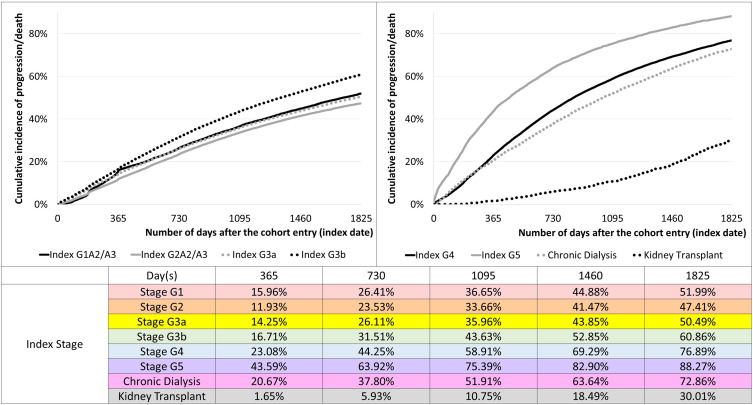
Click to Enlarge: Cumulative incidence of progression, including transition to advanced DKD stage or death. Source: Dove Press Diabetes Metabolic Syndrome and Obesity
SALT LAKE CITY — Veterans with diabetic kidney disease have a faster rate of stage progression compared to patients in the general population, and more than half of veteran diabetic kidney disease patients progressed to an advanced stage or died within 5 years, according to a recent study.
The retrospective observational study published in Diabetes, Metabolic Syndrome and Obesity aimed to estimate the rate of diabetic kidney disease progression and measure the general epidemiology of diabetic kidney disease in the United States veteran population. Study authors are affiliated with VA Salt Lake City (UT) Health Care System.1
Diabetes is the “leading cause of chronic kidney disease, a major public health issue. One in 3 adults with diabetes develops chronic kidney disease, and diabetic kidney disease, which has high mortality, accounts for 44% of new chronic kidney disease cases. The number of diabetic kidney disease patients in the U.S. is estimated to increase to 55 million by 2030. Though diabetes is the primary cause of chronic kidney disease and complications, the epidemiology of diabetic kidney disease in the contemporary U.S. veteran population is generally unknown,” according to the authors.
This study is the “first comprehensive description of diabetic kidney disease among U.S. veterans using statistics of the incidence of stage progression and diabetic kidney disease case count,” the researchers reported.
The researchers used electronic health care records and administrative databases to identify patients with diabetic kidney disease who sought VHA care from January 2016 to March 2022. The study involved 685,288 patients (96% male, mean age 62 years old, 64% Caucasian and 87% non-Hispanic), who met the eligibility criteria. Diabetic kidney disease patients were defined using laboratory test data based on Kidney Disease: Improving Global Outcomes (KDIGO) clinical practice guidelines, the authors explained.
The study team pointed out that “chronic kidney disease is characterized by reduced glomerular filtration rate (GFR), typically accompanied by elevated urine albumin and protein excretion.” The research team analyzed data “to determine the five-year cumulative incidence of progression to an advanced stage from the diabetic kidney disease stage at the cohort entry date and prevalence at a series of single time points.”
Underinvestigated and Underdiagnosed
“Based on the number of patients meeting two or more estimated glomerular filtration rate (eGFR) declination criteria, we likely missed a sizable number of patients in reporting their diabetic kidney disease status,” Kibum Kim, a research scientist at VA Salt Lake City Health Care System, told U.S. Medicine. “Particularly, patients who are at grade 1 or 2 (eGFR >60) are likely underinvestigated and underdiagnosed. The rate of DKD [diabetic kidney disease] stage progression among veterans, once occurred, is faster than the rate among general population DKD patients.”
The study found that “more than half of diabetic kidney disease patients underwent a stage progression or death within five years. The 5-year cumulative incidence of progression to an advanced diabetic kidney disease stage or all-cause death from diabetic kidney disease stages G1 A2/A3, G2 A2/A3, G3a and G3b were 52.0%, 47.4%, 50.5% and 60.9%, respectively. The authors determined that 594,082 patients were classified as moderate or high risk as per KDIGO guidelines in 2021, and stages G3a and G3b accounted for 51.2% and 25.3%, respectively, of cases.”
The most significant strength of the study is that it “used the entire VHA database to calculate diabetic kidney disease epidemiology. Previous studies performed in the VHA analyzed a regional cohort or a panel of diabetic kidney disease patients to estimate prevalence, which poses limitations in understanding the full scope of diabetic kidney disease in the entire health care system due to variations across facilities,” the authors explained.
The researchers noted that a “majority of patients (60%) were defined once their eGFR declined below 60 mL/min/1.73 m2.”
“Although providers acknowledge the benefits of early intervention, current healthcare services miss many patients whose rapid progression is preventable before the onset of progressive decline in kidney function,” Kim said. “Our findings underscore the need for innovations in healthcare that can intervene in early DKD [diabetic kidney disease] stages.”
The authors recommend for “healthcare professionals to follow patients with diabetes aggressively and regularly, particularly to determine the presence of diabetic kidney disease.”
“Early detection of a declined kidney function and proper risk stratification would be necessary once DKD [diabetic kidney disease] is determined,” Kim added.
This study’s findings “warrant a revision of diabetic kidney disease patient identification and management in U.S. veterans,” the authors suggested, adding that, with the estimated rise in the number of patients with diabetes and other comorbidities, “diabetic kidney disease will pose significant clinical and economic challenges for the VHA to address.”
“More exploratory research into treatment, diagnosis, and screening strategies is warranted to mitigate the prevalence of various diabetic kidney disease risk factors among U.S. veterans. In addition, the findings highlight the need for innovations in health care delivery in order to intervene at early diabetic kidney disease stages to delay progression into advanced stages, which can subsequently reduce the clinical and economic burden of diabetic kidney disease among U.S. veterans,” according to the report.
- Kim K, Crook J, Lu CC, Nyman H, Abdelaziz A, LaFleur J. Epidemiology of Diabetic Kidney Disease among US Veterans. Diabetes Metab Syndr Obes. 2024 Apr 8;17:1585-1596. doi: 10.2147/DMSO.S450370. PMID: 38616990; PMCID: PMC11011711.

